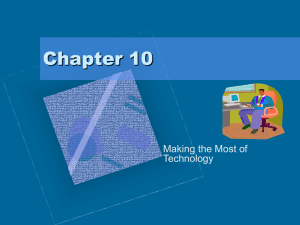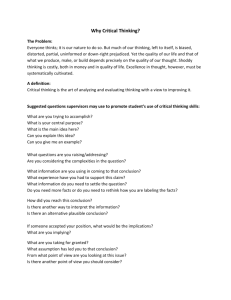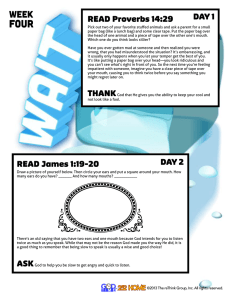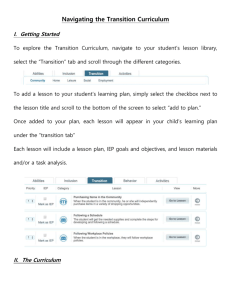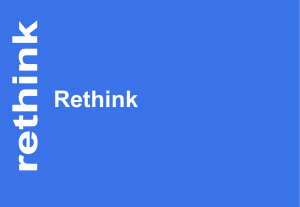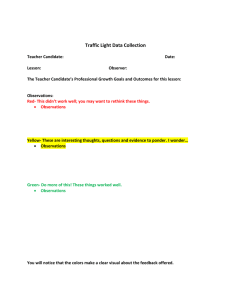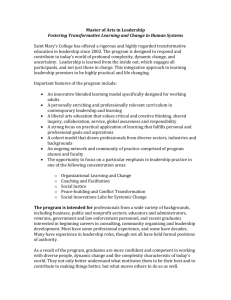Strategic Planning and Our Strategic Direction Utpal K Goswami
advertisement
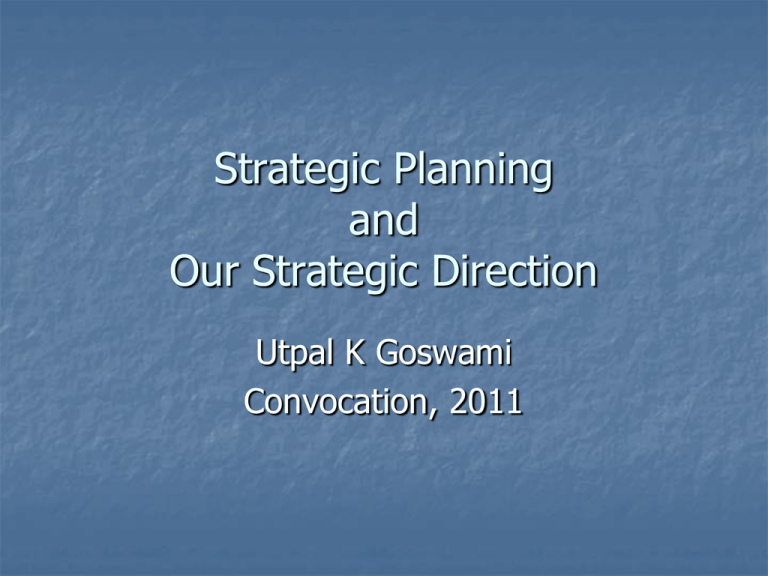
Strategic Planning and Our Strategic Direction Utpal K Goswami Convocation, 2011 Four Pillars of an Organization Mission—why are we here Vision—what will be our effect Values—principles that guide us Strategic Plan—where are we going Typical Reaction Boring! More Busy Work! Another One for the Shelf! Can we not recycle the old one! Sigh! Trust me—It can be very interesting What makes a Strategic Plan important and interesting? It It It It allows allows allows allows you you you you to to to to set the stage create the environment create a sense of purpose empower and, at the end of it all You will meet the future you wanted! Should We Passively Accept What Comes Our Way? Or Should We Chart and Control Our Destiny? We have opportunity to build the CR of the future Must Avoid Fatal Flaws Undue Importance to Current Issues Look inwards Focus on Tactical Matters Must Proactively Address The Future Success Factors for Strategic Plans Clarity—requires no elaborate explanations Representative—reflects its constituents Inclusive—result of broad based input Visionary—some elements transcend the obvious Accommodating—has space for local issues Flexible—nine ways to scale a mountain Success Factors for Strategic Plans Intentional—targets critical factors Emotive—provides intrinsic fulfillment Enticing—the journey itself is rewarding Empowering—space for individual initiative Validating—can see oneself making a difference Endowed—funded adequately We Are Near a Tipping Point I. Higher Education Operational Model is Financially Unsustainable Funding is primarily related to valuation and not the product Operational model is of increasing cost Hence, ever-increasing dependence on ‘developing alternative resources’ II. Discretionary Public Dollars are Rapidly Shrinking Unpredictable funding environment Calls for accountability Possible cost shifting III. Efficiency Gains in Higher Education Has Been Negligible Moore’s Law certainly does not apply to higher education Cost of transmitting information and knowledge is falling 50% every 18 months Even Surgeons have found ways to become more productive---Door is open for efficient provider IV. Our Numbers Don’t Look Very Good Community College graduation rate is about 18% Baccalaureate graduation rate is about 50% 70% of High School graduates are not college ready The Landscape is Changing The Learner Rise of informal learning—ready access to knowledge and information Rise of the pursuit of unrelated fields over a lifetime The Adult Learner No longer homogenous Knowledge & Learning Rapid expansion in knowledge Research on Retention of Knowledge Research on Half Life of Learning Concept of disaggregated knowledge Emerging Threats I. The Private sector is Gaining on Us Their Market Share is Increasing They are becoming Price Competitive They are close to getting a piece of the public dollars II. Operational Model is Becoming Less Relevant Basically a one size fit all model We sell only a fully loaded model Position of competitive vulnerability III. Internal Inertia Very little has changed over the last 200 years But we know 70+% graduates work outside their major Graduates are likely to change careers 5+ times Employers focus on competencies/skill sets Yet our focus is still discipline based IV. Disruptive Technology Internet-Broadband Collaboration Webs Gaming/Simulation Social Networking Collective Intelligence Lessons from the Pony Express Response to Telegraph--Buy faster horses When that did not work--Hire better riders A fundamental re-examination of the business was what was needed So How Should We Proceed? Evaluate External Trends Examine the Fundamental Tenants of Our Business Don’t Forget our Strategic Strengths Focus on Creating the Institution of the Future OK to think outside the box Fundamental Questions Knowing what you know, would you create what you have today? Why is what we have not enough? Why is $8,000+ per student not enough? Is the “Organizational Culture” and the “Infrastructure” our albatross? How should the organization evolve? Ask the Tough Questions—Empower Others to Ask the Tough Questions Rethink Rethink Rethink Rethink Rethink The Product What We Do How We Do It The Organization The Structure Epilogue It is not about doom and gloom It is an opportunity to set the stage for transformative change We can all do our part A collection of small changes will reach the threshold for transformative change Next Steps Committee (Sept 8 Kickoff) Conversations Anticipated Rollout in April 2012 Future Students Are Depending On Us!!
